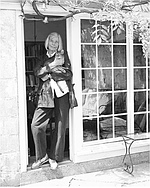In Memorium: Judy Tomkins October 17, 1926 – May 19, 2017
How Judy Tomkins came to live in Palisades is worth repeating. When a teenager living in Nyack with her mother, she was invited to go trick-or-treating with her friend Caroline Lalire, nee Abel, who lived on HeyHoe Woods Road. On Hallowe’en, the two girls walked down Washington Spring Road and crept around to the back of the Joshua Martin House where the young architect Rex Allen lived with his mother. They peered through the dining room window to see Mrs. Allen seated at the piano, dressed in a long black gown. She rose suddenly from the bench and turned slowly and stiffly toward the girls, who panicked and ran screaming back up the road. Once at a safe distance, Judy said to her friend, “One day I will live in that house.”
Her prognostication came true when she and her husband, the actor Henry Jones, were looking for a place closer to Broadway than their home in Bucks County. Judy’s mother contacted her friend Anne Gugler who remarked that the house next door, the same Joshua Martin house, was empty. Judy and Henry rented it until their divorce. Later, after Judy had married Calvin Tomkins, art critic for the New Yorker, she moved back to the house with him and when Rex Allen was finally ready to sell, they bought it.
Judy spent 60 years in that house, furnishing it with pieces of her own design, and turning it into a second home to some of the most important figures of American contemporary art. Through Leo Castelli’s gallery in Manhattan where she exhibited her acclaimed photographs, she befriended Jasper Johns and Robert Rauschenberg, among others, and for over a quarter of a century they gathered to celebrate Thanksgiving and Easter in their “favorite house on the Hudson” with a woman they credited with influencing much of their life and style.
Judy published two books of photographs: The first, The Other Hampton, about an economically depressed African American community in Bridgehampton trying to survive among affluent whites, with text written by Calvin Tomkins; The other, Coming Back, a memoir in pictures chronicling the aftermath of her divorce from him. John Russell, art critic of The New York Times wrote:
"Judy Tomkin's photographs have an emotional tone that is not like anyone else's… watchful, inquisitive and subdued; the images are elegantly composed, and the monitoring of skin, hair, sand, soap and clothing is as acute as in classical still-life painting. We never see a face, and yet these people are known to us; and we come away feeling that human dignity has been upheld, not exploited."
Judy was perhaps better known locally for her influence on the landscape of Palisades. She designed the gardens of many important properties, adhering to a philosophy of allowing “the genius of the place” to reveal how a landscape should be designed. Famous for ignoring limitations on her artistic vision, she often forgot where one property ended and the next began. Usually, all parties were happy with the result, although sometimes it had to be explained.
Stone tool sheds and domed farmers’ piles dotting the hamlet are markers of her legacy. They represent her ingenious solution to the problem of what to do with all the rocks that had to be removed from a bed or a scape.
Judy's own gardens and house have been featured in The New York Times, McCalls, Metropolitan Home, House Beautiful, Martha Stewart's Living and 10964. Her unique aesthetic has made a lifetime impression on those who stepped into her life as art.


